IPB University Professor Proposes Initial Concept of Ecosystem Services Assessment to KLHK

Currently the Directorate of Environmental Services Utilisation of Conservation Areas, Directorate General of Natural Resources and Ecosystem Conservation (KSDAE), MoEF, is designing an effort to assess environmental services as well as environmental quality performance assessment expressed through the IKLH (Environmental Quality Index) which has been formulated by the Directorate General of Pollution Control and Environmental Damage (PPKL) MoEF.
“With IKLH data, we can see trends in environmental quality temporally (over time) and spatially (in various places). IKLH can also illustrate the extent of efforts made in maintaining the water quality of rivers, lakes, and so on,” said Prof Hefni Effendi, Chairman of the Department of Aquatic Resource Management (MSP) FPIK IPB University.
Prof Hefni explained that a similar assessment is expected to be carried out on environmental services or ecosystem services. According to him, ecosystem services are defined as benefits (tangible and intangible) provided to humans through the transformation of environmental resources or assets, including land, water, plants and atmosphere, into a flow of goods and services, such as clean air, water and food.
Ecosystem services include provisioning services, which are a number of services that can be harvested or utilised directly. Services and products that can be harvested such as timber, clean water, and forest products. Regulating services include services provided by ecosystems in regulating the provision of clean water, pollination of plants, climate regulation, carbon storage. Cultural services in the form of aesthetic, comfort, religious services. Supporting services, in the form of services that allow the ecosystem to run, which include nutrient cycling services, provision of fertile soil.
“Carbon storage services in terrestrial forest areas have been studied quite a lot and there is already a carbon trading mechanism, one of which concerns the ability of natural forests in conservation areas to absorb carbon emissions released by anthropogenic activities, and store them as carbon storage,” said Prof Hefni Effendi, IPB University lecturer.
He explained that recently the concept of blue carbon has begun to develop, in the form of carbon absorbed and stored by plants related to the sea. Some ecosystems that can store carbon include mangrove forest ecosystems, coastal salt marshes and sea grass ecosystems.
“The science of blue carbon is currently intensively developed by the Department of Aquatic Resource Management (MSP) FPIK IPB University and at the same time as one of the competencies that must be mastered by MSP IPB University students,” said Prof Hefni Effendi.
He continued, it is these various ecosystem services that are to be quantified and assessed temporally and spatially. Given the broad spectrum of ecosystem services, he said, the basic concept of ecosystem service assessment needs to be formulated first. This is because there are tangible ecosystem services that can be utilised directly, and intangible services that cannot be utilised directly and require additional effort to quantify.
As explained by Prof Hefni Effendi, intangible services are not tangible, but their benefits can be felt in real terms. Ecosystem services that are clearly tangible are provisioning services because they can be harvested directly. “Meanwhile, regulating, cultural, and supporting services are forms of ecosystem services whose benefits we cannot harvest directly. But we feel the benefits significantly,” he said.
“Therefore, in the concept of ecosystem service valuation, are the four ecosystem services to be assessed? Or only tangible services will be quantified? This is what needs to be formulated first,” added Prof Hefni Effendi.
According to him, intensive literature review, brainstorming of experts, and benchmarking to countries that have the concept of ecosystem service valuation. “Thus, when our country has an ecosystem service (∞environmental) assessment mechanism, the results can be compared with other countries, because they have used a similar platform or assessment variable base,” said Prof Hefni Effendi. (IAAS/RUM)



